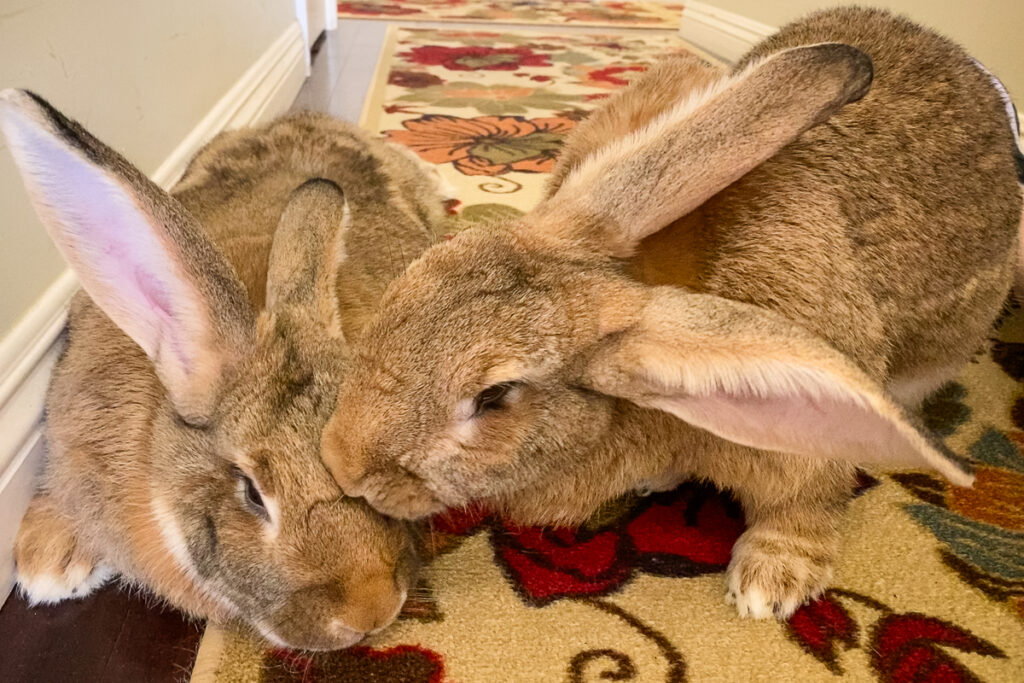Some decisions about caring for your rabbit are difficult to make. This isn’t one of them. This procedure prevents or solves all the most common behavior problems facing rabbits who live with humans. It prevents or cures serious health problems, too. In addition to living longer, happier, and healthier lives, spayed and neutered rabbits do not contribute to the tragic overpopulation problem. According to the Humane Society of the United States, rabbits are now the third most common animal abandoned at animal shelters. Until there are none, adopt one-or two-from animal shelters or rescue groups. How often do you find an option that is the right one for both self-interested and altruistic reasons?
HELP!
Here are excerpts from a few of the hundreds of e-mails sent to rabbit.org by people having behavior problems with their rabbits. In every case, the solution begins with spay/ neuter. For some situations, surgery alone will solve the problem; but more commonly, it complements behavioral techniques. Detailed descriptions of these are available at the Web site (see sidebar), in House Rabbit Journal, and in House Rabbit Handbook.
What’s With all the circling…
QWhy does our 5-month-old rabbit circle our legs at supper or make circles around us as we stand in the kitchen doing the dishes or just chatting?
AExplicit courting behavior such as circling, nipping, chasing, and mounting are sure signs that Speedo has reached sexual maturity. There’s no need to wait for these to appear. Males can be neutered as soon as the testicles descend, usually between 10-16 weeks. Females should be 6 months old. In the hands of an experienced vet (see sidebar), spay/neuter is a procedure that a young healthy rabbit should have no problem recovering from. For older rabbits, your vet may add some tests to the pre-operative check-up.They Used To Get Along…
QCupcake and Muffin have been together since they were babies. Cupcake had her first litter last month. Ever since then, she and Muffin don’t get along anymore. They’ll be sitting quietly and then Muffin will try to mount Cupcake and before you know it the fur is flying. Sometimes Cupcake will back down or run and hide, but sometimes she won’t, and we have to pull them apart. They were such a happy couple and now they hate each other. We were told that having them spayed and neutered might help, but my husband is totally against it. He says it’s unnatural, and how would we feel if someone did that to us?
ARabbits have a natural craving for the companionship of their own kind. Unaltered rabbits housed together will fight and breed, injuring themselves and adding to the overpopulation problem. Spay/neuter surgery may be “unnatural,” but it enables the lifelong, loving, gentle relationships we see in our foster homes. Once rabbits start fighting, it’s important to have them spayed/ neutered as soon as possible, before fighting becomes a habit that may be difficult to undo.My bunny is peeing on my bed…
QMy rabbit is litterbox-trained, but recently he’s been jumping on my bed and wetting on the sheets. It is usually in the same place but if I’m lying in bed he’ll jump on my chest and wet on me. Any suggestions?
AA sudden change in elimination habits is sometimes a sign of illness. The first step is a trip to the vet for a complete exam. In healthy unaltered rabbits of both sexes, the hormonal urge to mark territory with urine and feces is powerful. Surgery alone may not solve all litterbox-training problems; but without it, other solutions are unlikely to succeed. For a detailed description of litterbox-training, read HRJ vol.3, no.12, pp.4-5.My rabbit had babies and they died…
QMy rabbit had babies last week. They all died the day after they were born. The mother rabbit has been hiding from us ever since. How long should we wait before breeding her again? How can we make sure the babies don’t die?
ABirth is no miracle for many rabbits. Mother Nature designed them to live fast, produce lots of offspring, and die young. This is one of the few areas where we humans can actually improve on the natural cycle; the life span of a spayed/neutered house rabbit is 8-12 years. Unspayed rabbits are at high risk for uterine tumors. The stress associated with her fertility cycle, pregnancies (real and false), and caring for baby bunnies leaves her vulnerable to opportunistic infection. Because rabbits do not have a high-performance immune system, such infections can be lethal. Another entry point for infection is the bite and scratch wounds incurred in fights, which are much more frequent in unaltered rabbits.A sudden aggressive attitude…
QRecently our rabbit has been having a very aggressive attitude towards everyone and everything in our house. She attacks the cat while he is just walking by or when he is sleeping. She has bitten me at least 3 or 4 times for no apparent reason! Whenever me or my mom reach into the cage she attacks us or bites us and GRUNTS loudly! She also digs and bites and pulls up any surface she is on whether it be grass or the carpet (my mom is very mad about this). She attacks anything in her path instead of going around it. Before she did these things she was very nice and never bit us! Why does she do these things and how can we get her to stop? We never abused her and she always gets A LOT of attention even though she can be mean! Sometimes I discipline her by lightly tapping her on the nose and saying NO! when she starts to chew on something but it never works! PLEASE PLEASE Help!!!
AThis stressed-out rabbit and her end-of-their-rope humans will reap the benefits of spay surgery in the months following the operation. Spay/neuter greatly reduces the behavior changes that accompany sexual maturity, but it doesn’t eliminate them entirely. Nor does it change the rabbit’s basic personality. After the surgery, you will still have a teenager on your hands (adolescence ends at about 18-24 months). That’s where the behavioral approach takes up the task. Read all about adolescence at HRJ Vol.2, No.9.Saving Lives Every Which Way
This operation will even save the lives of rabbits you’ll never meet, who were adopted because of the shining example set by your happy, healthy, well-behaved pair.
Remember the other day, when you were talking about your spayed/neutered rabbits at coffee break? Someone in the room went to the library that very day and borrowed House Rabbit Handbook. Starting next week, they’ll be visiting a foster home in your area to adopt a pair of rabbits.
On behalf of needy bunnies everywhere, we thank you.

